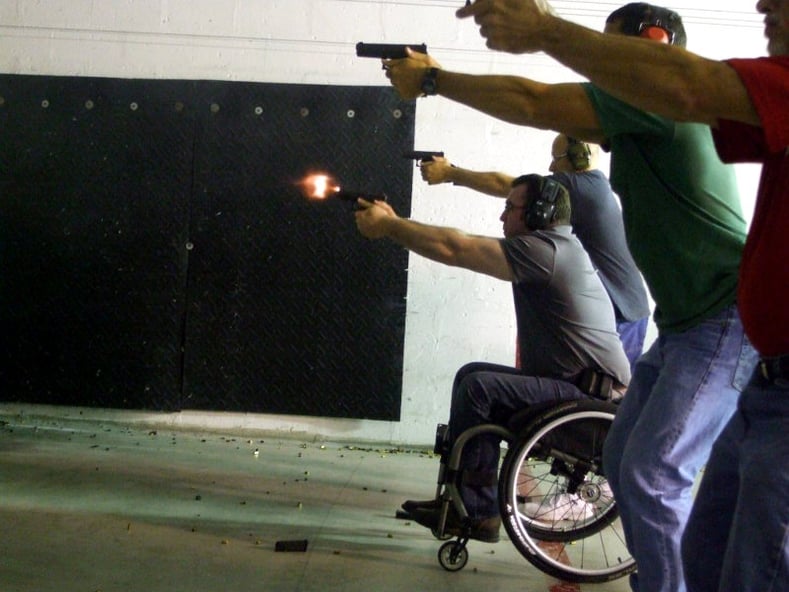This is a topic that came via request from our Facebook fans. In the concealed carry community, we all know how important it is to strive for realistic conditions in our training. Not only does this tune us in for realistic expectations in an actual self-defense situation, it develops a certain amount of “muscle memory” necessary for fast, judicious reaction.
But what happens if the carrier has short or long-term physical disabilities? How important it is for people with short and long term physical disabilities to practice real world carry and protection?
It’s always important.
At the same time, it’s important to know what those physical limitations are and how to incorporate them appropriately into training. As surprised as some concealed carriers may be, there are some gunowners that are blind. We covered an article where one Iowa law enforcement officer helps train blind people to shoot. And then there’s the actual real-world defense situation where an elderly, blind woman scared off burglars with her gun. We’re just using a couple examples of how the visually impaired have managed to overcome their disabilities to protect themselves.
Develop A Training Regimen That Incorporates Limitations
The first step to concealed carry firearms training with a short-term or long-term disability is acknowledging that a limitation exists. If a concealed carrier is wheel-chair bound due to an accident, injury, or disorder, it’s vitally important to ensure that any proposed training regimen incorporates those things — and you have consulted with your healthcare providers beforehand.
Step 2: Turn Those Limitations Into Advantages
Find any way you can turn your limitation into an advantage in your training. Violent criminals may seek out those with disabilities as easy or soft targets. The last thing they’ll be expecting is staunch resistance. But with training and the right self-defense mindset, they won’t know what’s hit’em until it’s over.
- Train for household self-defense
Practice maneuvering around your home, using the building to your advantage. You will likely know the interior of your own home better than your attackers. What’s the least amount of movement you need in order to get into a good defensive position? That’s called an economy of movement.
- Set yourself up for success
Real-world training doesn’t always necessitate live-fire. You can train to maneuver in your home, in the vehicle, and anywhere you frequent regularly. A big part of that is setting yourself up with the right equipment. If an inside the waistband concealed carry holster will not feasibly work, find what does. Here’s three major ingredients that ought be considered when finding what works for you:
Safety
Accessibility
Familiarity
Where-ever you position your firearm, make sure the trigger is protected from any contact. Think ahead to the movements you generally make throughout the course of a day. Is there a place you can position a firearm so that it is adequately protected by a holster?
And then comes accessibility. If you can’t readily gain access to the firearm, it’s useless. But before it can be accessible, it has to be safely stored. And lastly, whatever you decide — practice it. In actual live-fire drills at the range, position your concealed carry handgun precisely where you would intend to draw it from. Adjust accordingly until you find the perfect mix of all three.
Step 3: (Advanced) Practice Overcoming Your Disadvantages On The Battlefield
If you know what your limitations are, your enemy may as well. For instance, if your leg does not have a normal range of movement and you’re unable to run and take cover, practice dropping to the ground and reducing your target silhouette. In training, incorporate the likelihood you may be placed in a situation where your ability to move at your own pace is compromised. This will train you to ascertain the situations of the environment and act accordingly.
Short and long-term disabilities do not dictate life or your right to defend yours. Training will improve your chances and give you realistic metrics if you should deal with a real-world self-defense situation. The best thing you can do is be realistic with your expectations and train to turn your weaknesses into strengths. Seek out help from firearms instructors versed in real-world scenario training to discover different styles and techniques that may improve your efficacy with defensive firearm handling — and always keep training.














![[VIDEO] The Cup Song – Pitch Perfect – With Guns](https://imagedelivery.net/sbm_lYeJbALkepJgtmRD5w/concealednation.org/2015/01/ScreenHunter_44-Jan.-01-14.11.jpg/w=728,h=381)